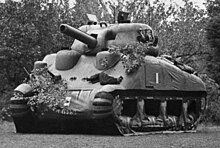Tank dummy
Tank dummies are dummies of armored vehicles, especially battle tanks .


Types of use of dummy tanks
illusion
The task of tank dummies is to mislead an opponent into misjudging the line-up, vehicle types and the activities of their own tank troops.
education
Dummy tanks made from inexpensive materials can also be used for training purposes or as targets in peacetime. Vehicles that are ready to drive but are not fully operational - such as a tank whose turret has been replaced by a dummy - are often used as driving school vehicles.
Construction
In addition to prefabricated products, dummies can also be improvised from earth, snow, construction and packaging material in order to deceive an observer. Since radar and infrared sensors have been increasingly used for reconnaissance in addition to optical observation, the corresponding properties of tanks ( radar reflective surface and heat radiation) have to be imitated by a dummy in order to maintain the deception.
It is far easier for drones than for manned fighter planes to detect dummies because they fly much slower. Images are transmitted digitally and can be evaluated using a computer. Drones have a longer flight time than manned military aircraft. You can circle over an observation area and film objects from different angles.
Calls
Pre-war and World War II
Due to the armaments restrictions of the Versailles Treaty , which had forbidden the Reichswehr to maintain tanks, Heinz Guderian had tank exercises carried out with tractors and cars ( Hanomag Kommissbrot ) as a basis for tank replicas and with wooden dummies for training purposes from 1927 . Dummies were used on a large scale during the Second World War as part of Operation Fortitude in 1944 to distract from preparations for the invasion of Normandy (from June 6, 1944).
Kosovo War
During Operation Allied Force in 1999, NATO air forces attacked Serb forces in Kosovo . Numerous tanks, which were initially recognized by aerial photographs or by the sensors on board of combat aircraft and later attacked, were dummies. There were those that either simulated the outlines of armored vehicles and were improvised on site made of Tetra-Pak packaging material and other improvised solutions that imitated the heat radiation of tank engines in order to fool the sensors of aircraft.
literature
- Jack Kneece: Ghost Army of World was II. Pelican Publishing Company, Gretna LA 2001, ISBN 1-56554-876-0 .
- Jochen Vollert: Dummy tanks. History and variants of the German tank display media, anti-tank training media and training tanks 1916–1945. = German dummy tanks. History and Variants 1916-1945. Vollert Tankograd, Erlangen 2009, ISBN 978-3-936519-20-4 ( Tankograd Wehrmacht special 4013).
Web links
- Christoph Gunkel: Deployment of the rubber army . one day , April 20, 2010.
- The Ghost Army
Individual evidence
- ↑ Bob Carruthers: Red Army In Combat 1941-1945. Chapter: Russian Tank Camouflage In Winter.
- ↑ Hanomag Defense Technology , Hanomag Museum
- ^ Arnulf Scriba: Heinz Guderian. Tabular curriculum vitae in the LeMO ( DHM and HdG )
- ^ Operation Fortitude , wlb-stuttgart.de
- ^ Benjamin S. Lambeth: Nato's Air War for Kosovo: A Strategic and Operational Assessment. Issue 1365, Rand Corp, 2001, ISBN 978-0833030504 , p. 130.
